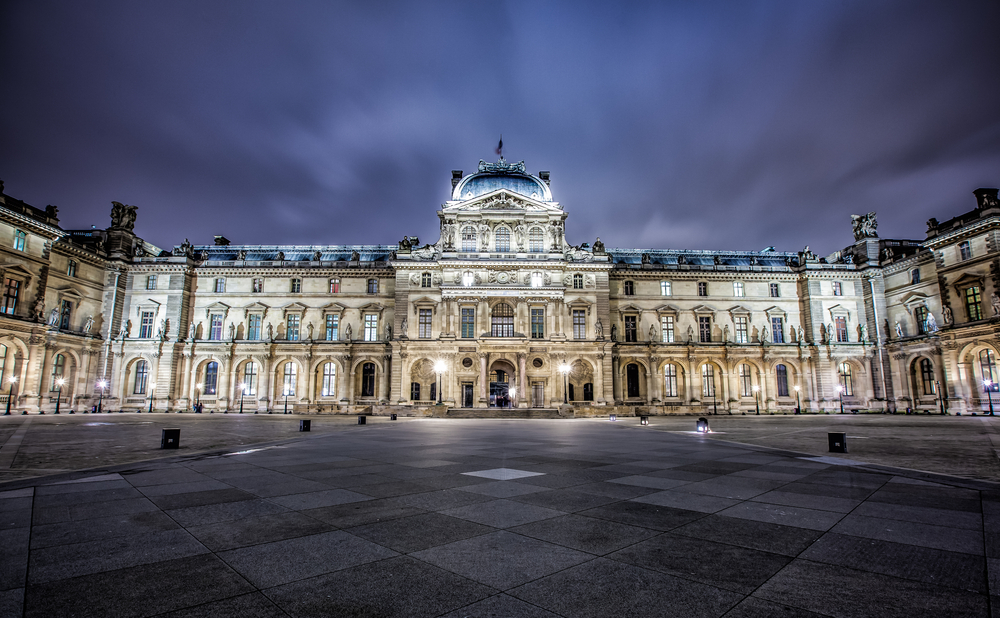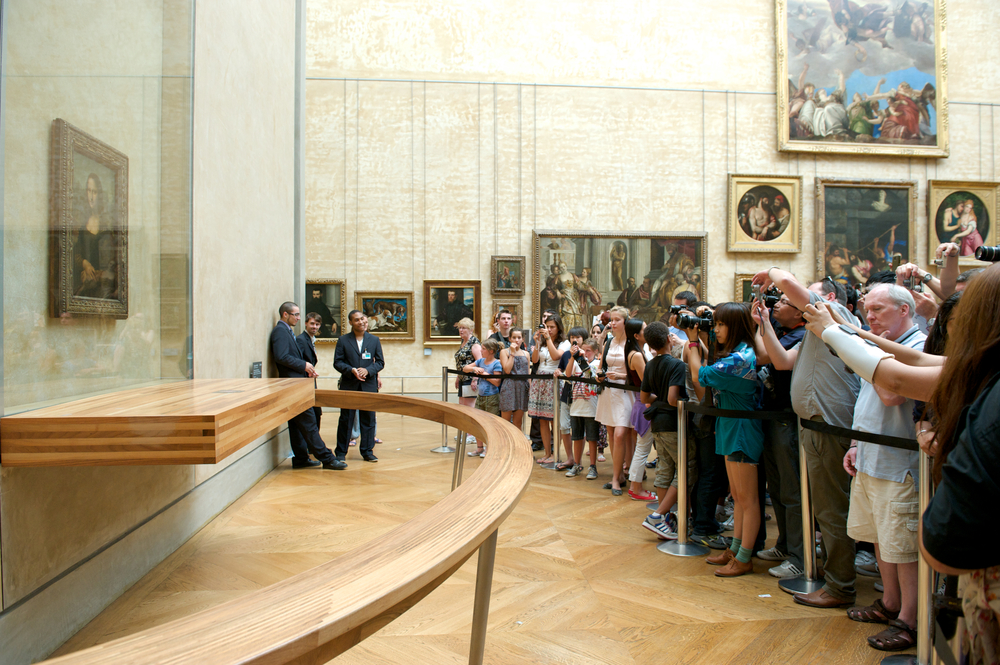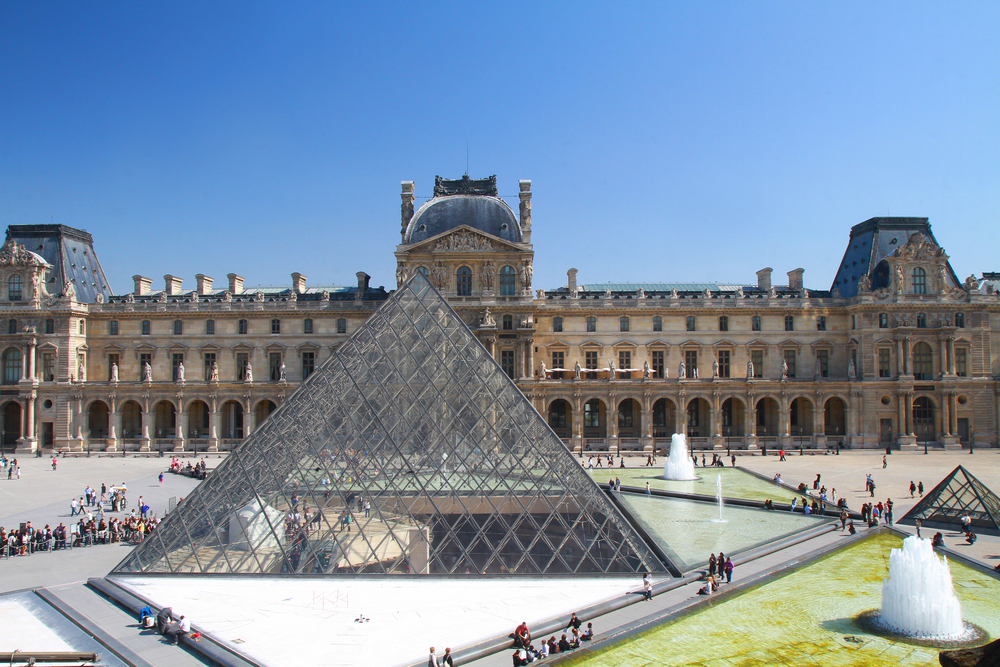What Was the Louvre Before It Was an Art Museum?
The Louvre Museum: Facts, Paintings & Tickets

The Louvre is the world's largest museum and houses one of the most impressive fine art collections in history. The magnificent, bizarre-fashion palace and museum — LeMusée du Louvre in French — sits along the banks of the Seine River in Paris. It is one of the city's biggest tourist attractions.
History of the Louvre
The Louvre was originally congenital as a fortress in 1190, only was reconstructed in the 16th century to serve as a royal palace. "Like many buildings, it was built and rebuilt over the years," said Tea Gudek Snajdar, an Amsterdam-based art historian, museum docent and a blogger at Culture Tourist.
During its time as a imperial residence, the Louvre saw tremendous growth. Nearly every monarch expanded it, according to History.com. Today, it covers a full area of 652,300 square feet (sixty,600 square meters). In 1682, Louis XIV moved the purple residence to Versailles, and the Louvre became abode to various art academies, offering regular exhibitions of its members' works.
During the French Revolution, Louis XVI and his wife, Marie Antoinette, were forcibly removed from Versailles and imprisoned in Tuilleries Palace, which was then adjacent to the Louvre, co-ordinate to the Louvre'south official website. They were beheaded there in 1793.
The National Associates opened the Louvre as a museum in August 1793 with a collection of 537 paintings. The museum closed in 1796 because of structural problems with the building. Napoleon reopened the museum and expanded the collection in 1801, and the museum was renamed Musée Napoléon.

"Information technology was Napoleon Bonaparte who created the foundation for the world famous museum the Louvre is today," said Gudek Snajdar. "He wanted to be in charge of creating a drove of art in Louvre. That'due south why he renamed it in 1802 to the 'Napoleon Museum.' He wanted to create a museum of French republic with a wonderful collection of art from all around the world. He enlarged its drove by bringing fine art from his military campaigns, private donations and commissions he made."
Napoleon'southward contributions included spoils from Belgium, Italy, Prussia and Austria, according to Napoleon.org. In 1815, when Napoleon abdicated with the Treaty of Fontainebleau, near 5,000 artworks were returned to their countries of origin. France was allowed to keep only a few hundred works, and the Louvre reverted to its original name. Many artifacts from Napoleon'southward conquests in Egypt remained, according to History.com.
After Napoleon, the Louvre continued to expand. The multi-building Louvre Circuitous was completed under the reign of Napoleon III in the mid-19th century, according to napoleon.org.
Louvre paintings & other works
The Louvre'south collection includes Egyptian antiques, aboriginal Greek and Roman sculptures, paintings by the Former Masters (notable European artists from before 1800), and crown jewels and other artifacts from French nobles. Its works bridge the sixth century B.C. to the 19th century A.D. More than 35,000 works are on display at whatever given time. The displays are divided into viii departments: Almost Eastern Antiquities; Egyptian Antiquities; Greek, Etruscan and Roman Antiquities; Islamic Art; Sculptures; Decorative Arts; Paintings; and Prints and Drawings, according to the Louvre website.
Without question, the Louvre'southward near famous work is Leonardo da Vinci's "Mona Lisa," who enchants hordes of visitors with her enigmatic grin. This small, iconic painting — information technology is but 21 by thirty inches (53 by 77 centimeters) is covered with bullet-proof glass and flanked by guards, co-ordinate to the Louvre website. This protection is the upshot of it being stolen in 1911. (It was recovered in 1913.)
Crowds as well flock to see the armless dazzler of the "Venus de Milo," and "Winged Victory," the ancient Greek sculpture also known every bit "Nike of Samothrace." Other popular works include a stele inscribed with the Lawmaking of Hammurabi, da Vinci's tragic sculpture "The Dying Slave" and Antonio Canova's 18th-century sculpture "Psyche Revived past Cupid'south Kiss." Eugene Delacroix's "Liberty Leading the People," which depicts the blank-breasted Freedom goddess leading a accuse in the French Revolution, and is idea to take inspired Victor Hugo's "Les Miserables," and Jacques-Louis David's "The Coronation of Napoleon" was deputed past Napoleon himself and is a good reminder of the Louvre's history.
Gudek Snajdar gave Live Science some unique Civilization Tourist recommendations. Some of her favorites come up from the collection of About Eastern Fine art. She recommends the "Frieze of Archers" from the sixth century B.C. and "Winged Bull with a Human Head" from the 8th century B.C.
She besides suggests viewing another masterpiece by da Vinci, "The Virgin and Child With Saint Anne," which is very close to the "Mona Lisa."
"Instead of getting lost in a crowd in forepart of the 'Mona Lisa,' I would definitely accept a look on that painting and savor the piece of work of this Italian painter in a peace and quiet," she said. Also, "a few of Johannes Vermeer's paintings are definitely not to be missed (especially when yous know at that place are only 34 of them in the world). It's a nifty opportunity to run across some of them."
Compages of the Louvre
"Although today its collection is the nigh interesting part of the museum, the building itself is an important exhibit, too," said Gudek Snajdar. The building is primarily of Renaissance and French Classical way, she said. The commencement medieval elements from the old fortress can still be seen undercover, beneath the pyramid, around the anteroom surface area.
"Probably its most famous part is Claude Perrault'south 'Colonnade' on the eastern façade of Louvre," said Gudek Snajdar. "Information technology was congenital in the 17th century and information technology's a wonderful example of a French Classicism. It'southward equanimous of paired Corinthian columns with pavilions at the corners of the facade." She said had influenced many buildings — the U.Southward. Capitol in Washington, D.C., and the Metropolitan Museum in New York being only some of them.

The Louvre pyramid
In 1983, the Louvre underwent a renovation plan known as the Grand Louvre, according to History.com Part of the plan called for a new design for the main entrance. Builder I.M. Pei was awarded the projection, and he designed an underground antechamber and modern glass pyramid structure in the courtyard. Inaugurated in 1988, the pyramid would go a celebrated element of the landmark museum'south design. "Information technology is my personal favorite," said Gudek Snajdar. "Combining traditional manner with mod architecture, it shows the Louvre's timeless beauty."
In 1993, the Inverted Pyramid, a skylight dipping into the underground lobby, was unveiled, according to the Louvre website.
Louvre tickets & hours
Considering of its size and the scale of its collection, it is impossible to see the entirety of the Louvre in ane visit. The museum reported about eight.i million visitors in 2017 — and so prepare for crowds, especially around the most popular works.
The museum offers a variety of tools to help visitors plan their days, including the "Masterpieces Visitor Trail," timed at about 90 minutes and covering the 10 most famous works, maps of flooring plans and advanced ticket options.
The Louvre is open every twenty-four hour period but Tuesday and the post-obit holidays: Christmas Day, New Year'southward Day, and International Workers' Solar day (May 1). The hours are: Monday, Thursday, Sat, and Sunday from nine a.yard. to half dozen p.m., and Wednesday and Friday from 9 a.1000. to ix:45 p.m.
As of 2018, access to the entire museum costs 15 euros (17 euros if ordered online). Admission is complimentary for those under 18, as well as other individuals with proper documentation, such as fine art teachers, pass holders and people with disabilities. Admission is also gratuitous on certain special days, such as Guardhouse Day (July 14).
Source: https://www.livescience.com/31935-louvre-museum.html#:~:text=The%20Louvre%20was%20originally%20built,a%20blogger%20at%20Culture%20Tourist.